Events & News
Fall 2008
Message from the Department Head
As the new head of the Department of Computer Science at the University of Arizona, I welcome you to our community. Who are we, exactly? The answer changes almost daily as we attract new faculty and students and develop new collaborations with colleagues in the biological sciences, the cognitive sciences, mathematics, and other disciplines here at UA and beyond. In the past year, the department recruited David Lowenthal from the University of Georgia as a full professor, Clayton Morrison and Yu-Han Chang from USC/ISI as research assistant professors, and myself. Thanks to the efforts of Greg Andrews, Kobus Barnard, John Hartman, John Kececioglu, Rick Snodgrass and Suzanne Westbrook, the department helped UA secure a major, $50M award from the National Science Foundation for interdisciplinary work to solve grand challenge problems in the plant sciences, thereby strengthening our collaborations with the BIO5 Institute and our work in computational biology and computational infrastructure for the life sciences. The department is strongly committed to outward-looking computer science and it recently decided to organize research around "focal problems" that afford opportunities for basic research in computer science in the context of societally important challenges. Good focal problems cannot be solved by computer scientists alone, so they create mutual dependencies --- the strongest kind of collaboration --- between researchers in our department and others at this great university. We are working with our colleagues to refine the department's first focal problems in the areas of computational biology, K12 education, the science of software systems, and security.
The last couple of years have brought substantial increases in research funding, so we are recruiting top undergraduate and graduate students, research professors, and tenure-track faculty. Let me tell you what attracted me to Computer Science at the University of Arizona: The department itself, the excellent ECE and MIS departments, the BIO5 Institute, the cognitive science program, the graduate interdisciplinary program in statistics; the fact that everyone I meet is openly enthusiastic about collaborations with Computer Science and sees computing as an essential part of their research; the agile, forward-looking administration, particularly our Dean in the College of Science, Joaquin Ruiz; and Tucson, itself, a delightful city with excellent schools in a glorious natural environment. I hope you will consider joining our community!
Research Awards
Bongki Moon has been awarded an 18-month grant for $140,000 from The National Science Foundation for support of the project entitled "SGER: Flash Memory DBMS for Transactional Database Applications." Flash memory storage devices are now considered to have tremendous potential as a new storage medium that can replace magnetic disks. Flash memory, however, has its own limitations such as erase-before-update and exhibits poor performance for small-to-moderate sized writes requested in a random order. The goal of this project is to develop new flash-aware designs and optimization strategies that allow large-scale transactional database applications to run efficiently on computing platforms equipped with flash memory storage devices as a main storage medium. The findings from this project will not only overcome the limitations of flash memory but also exploit the advantages of flash memory for transactional database workloads exhibiting randomly scattered data access patterns.
Richard Snodgrass was awarded an NSF grant entitled "III-COR Medium: Collaborative Research: Achieving Compliant Databases" for three and a half years for $279,833 (UA portion). Professor Snodgrass is a co-PI along with Radu Sion of Stonybrook University; the PI is Marianne Winslett of the University of Illinois at Urbana-Champaign. This research complements the existing market for compliance storage servers, which guarantee that data are not overwritten before the end of their mandatory retention period. These servers are intended for preserving unstructured and semi-structured data at a file-level granularity---email, spreadsheets, reports, instant messages. In this research we will develop and explore a DBMS architecture that supports a spectrum of approaches to regulatory compliance, each appropriate for a particular domain, and each with different tradeoffs between security and efficiency. The key challenge of this work is to provide compliance assurances for the DBMS, even against insiders with superuser powers, while balancing the need for trustworthiness against the conflicting requirements for high performance and low cost. To meet this need, our architecture will provide tunable tradeoffs between security and performance, through a spectrum of techniques ranging from tamper detection to tamper prevention for data, indexes, logs, and metadata; tunable vulnerability windows; tunable granularities of protection; careful use of magnetic disk as a cache; judicious use of secure coprocessors on the DBMS platform and compliance storage server platform; a block-based compliance storage server; and judicious retargeting of an on-disk encryption unit. This research extends Professor Snodgrass's prior work in tamper detection in databases, which has resulted in papers in SIGMOD, VLDB, and ACM TODS. http://www.cs.arizona.edu/projects/tau/tbdb.
Chris Gniady and John Hartman very recently won a $300,000, three year award from NSF called "CSR-PSCE,SM: Virtual Watts: Energy Management in Virtual Environments". The research focuses on the intersection of energy management and virtual machine environments. Current energy management algorithms are implemented in operating systems and rely on detailed application, system, and device monitoring to manage devices and improve energy efficiency. Virtual machines make energy management more complicated in several ways. First, a virtual machine lacks the application context that is available to an operating system. Second, a guest operating system is confined to its virtual machine, and therefore lacks global information. Third, virtual machines typically present virtualized devices to the guest operating systems, so that a guest operating system no longer has detailed energy profiles of the physical devices. This project investigates the proper distribution of functionality between the guest operating system, virtual machine, and underlying virtual machine monitor so as to improve overall system energy efficiency. Guest operating systems must collaborate with the virtual machine monitor to exchange information about current context, device state, and global information. The challenge is to provide the desired information flow while preserving the isolation provided by virtualization. Solving this challenge is critical since future systems will rely heavily on both energy efficiency to prolong battery life and reduce energy costs, and virtualization to provide isolation and portability, among many other benefits.
Faculty Updates
Associate professor John Kececioglu is Conference Chair for RECOMB 2009, the 13th Annual International Conference on Research in Computational Molecular Biology, which will be held May18-21, 2009, in Tucson, Arizona. The University of Arizona's BIO5 Institute is the host institute for the conference. For more information, visit www.bio5.org/recomb2009.
Clayton T. Morrison joined the faculty in September as an assistant research professor. Prior to joining the department, he was a computer scientist at the University of Southern California's Information Sciences Institute. His research straddles the disciplines of computer and cognitive science, with specific interest in how cognition develops in young children, and how to model and implement human-inspired learning systems using techniques from machine learning, AI planning and knowledge representation.
Recently, Clay has been very interested in probabilistic graphical models and computational approaches to causal reasoning. Clay's current and past projects have also involved creating simulators and virtual environments for training and use as data sources. Clay received his M.A. and Ph.D. in Philosophy from Binghamton University in New York and received his M.S. in Computer Science from the University of Massachusetts, Amherst. His B.A. in Cognitive Science is from Occidental College, Los Angeles, California.
Monte Lunacek joined the department in August as a postdoc working with the department chair, Professor Paul Cohen. His research interests include parameter optimization using evolutionary algorithms and other forms of heuristic search. Monte received his Ph.D. in Computer Science at Colorado State University in May 2008.
David K. Lowenthal will join the faculty in January 2009. Professor Lowenthal is currently a faculty member at the University of Georgia. His research centers on parallel and distributed computing, operating systems, and networks. Most of his current and past research projects involve addressing fundamental parallel computing problems, such as data distribution, scalability prediction, and energy reduction, through a system software perspective.
Professor Lowenthal received his Ph.D. from the Department of Computer Science at the University of Arizona; his M.S. in Computer Science from the University of Arizona, and his B.S. in Computer Science from the University of California, Davis.
1st Annual Integration of Science and Computation Camp
Associate professor Kobus Barnard and computer science alumna Ekaterina Spriggs created the Integration of Science and Computation Summer Camp. This is the first year for the NSF-funded camp that gives middle-school age students the chance to learn more about research, math and science, according to Spriggs, who is now in the PhD program at Carnegie Mellon University.
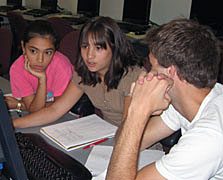
The camp included daily activities in collaboration with the College of Education, Arizona Laboratory for Immersive Visualization Environments, five biological research labs, and the UA-affiliated Wildcat Charter School. Students from the Wildcat Charter School attended the first session of the camp, and members from the Saguaro Girl Scouts attended the second session.
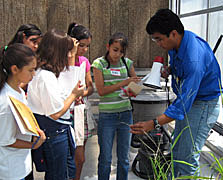
During the camp, the students visited the AZLIVE visualization facility and biological research labs where they learned about ongoing research. Further, the students collected the image data needed for modeling projects that were the focus of the second part of the camp. Here the students built 3D geometric models for Saguaros, Rice, and Alternaria (a microscopic filamentous fungus).
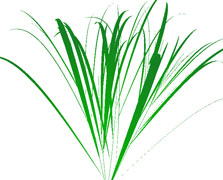
On the final day the students presented their projects on the Computer Science 3D display to family and friends. For the presentations the students had to explain to their audience what the problem was, why it was important, and how their activities addressed it. The camp emphasized how computation impacts sciences and how collaboration across disciplines was both important and fun.
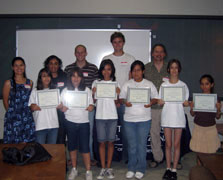
Many people contributed to the camp including students who helped run it (Ranjini Swaminathan, Spencer Rogers, Danny Mathis, Joseph Schlecht, Praneel Reddy, Barbara Anderson, and Tasneem Kaochar), community liaisons (Sara Chavarria, Michelle Higgins, Lydia Gonzales, and Edith Rodriguez), collaborators (Barry Pryor, Ravi Palanivelu, David Hearn, Rod Wing, Paul Sanchez, Nirav Merchant, and Marvin Landis), external judges (Suzanne Westbrook, Martha Narro, and College of Science Dean Joaquin Ruiz), and Computer Science Financial and Administrative Services group, Laboratory Staff, and the Academic Services group. Further information is available at the ISC website: http://vision.cs.arizona.edu/ISC.
Undergraduate Program
Jerrica Jones, a pre-computer science sophomore, attended the CompArch Summer School on Parallel Programming and Architectures. Hosted by Brown University, this workshop reaches out to under-represented minorities and women in computer science or computer engineering degree programs. The workshop exposed students to parallel programming and the components of computer architecture that have influenced it. In addition to lectures from industry professionals, Jerrica and her peers worked on a parallel programming project and presented their findings.
“Overall, I think it was a very beneficial experience. I was able to network, and meet other students from different schools. I was also able to talk to professors and graduate students about the various projects they had going on. This was very interesting, and it showed me that the University of Arizona has a pretty good computer science program. I would definitely recommend the workshop to anyone who is interested,” said Jerrica.
Jerrica also participated in Google’s Computer Science Summer Institute. Visit http://www.youtube.com/watch?v=S9ROqjfpKbM to learn more about her experience at the Institute.
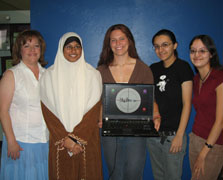
Five computer science undergraduate students won the first place prize of $1000 per team member in the Games 4 Girls competition for their creation of a computer game called SkipTracer. Members of the team were Barbara Anderson, Tasneem Kaochar, Kendra Walworth, Marlene Cota and Genevieve Max. UA Computer Science also received $1000 to fund strategies to attract more women to the program.
The spring competition, hosted by the University of Illinois at Urbana-Champaign, challenged teams comprised of college women to develop a computer game that would spark the interest of young girls. To learn more click on http://www.cs.uiuc.edu/outreach/games4girls.php.
Graduate Program
During the 2007-08 academic year 21 students graduated with a Master of Science degree and seven doctoral degrees were conferred. These talented alumni are now employed by companies such as Google, Rincon Research, Raytheon, Microsoft and Bloomberg. Graduates also accepted postdocs at MIT, IBM T.J. Watson Research Lab and the University of Wisconsin-Madison.
Alumni Credit Professional Success to Computer Science Degree
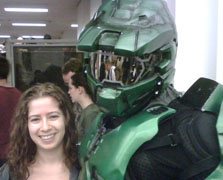
Kelly Heffner
B.S., Computer Science, ‘01
Company: Peerium, Inc.
Education: PhD Candidate, Harvard University
In the center of Harvard Square, University of Arizona alumna Kelly Heffner is putting her computer science degree to use at Peerium, Inc., the start-up company that she co-founded with two friends.
According to Kelly and her team, “Peerium is creating a new software platform for direct, real-time communication and collaboration within graphically rich environments. This new environment supports the effortless sharing of both information and software, and will enable a level of online cooperation far beyond current Web-based technologies.”
Working in a start-up business keeps this entrepreneur on the move. “First and foremost, I am one of the primary architects of the interpreter, virtual machine, and accompanying libraries for our new programming language. I also serve as a technical lead for other developers at the company and coordinator for our undergraduate interns. Sometimes I make the coffee.”
Kelly offers computer science students this advice. “I remember listening to computer science graduates, when I was still an undergrad, and being skeptical when they told us that the real knowledge they used everyday was the fundamentals they learned from class. It’s true! Even something as simple as an introductory programming exercise builds that foundation you will need later.
“Imagine my surprise when I needed to write an expression balancing algorithm for our compiler and I knew exactly how to do it, because of my infix expression balancing assignment from Rick Mercer’s CS127b class. The benefits aren’t always that direct, but knowing your fundamentals will help you understand and find creative solutions to any problem thrown at you.”
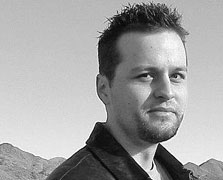
Brad Traweek
B.S., Computer Science, B.S., Mathematics ‘95
M.S., Computer Science ‘97
Employer: Fender Musical Instruments Corporation
Job Title: Manager of Web Development
Fender, based in Scottsdale, Arizona, is the world’s foremost manufacturer of guitars, basses, amplifiers and related equipment. With an illustrious history dating back to 1946, Fender has touched and transformed music worldwide and in nearly every genre: rock ‘n’ roll, country and western, jazz as well as rhythm and blues.
Brad and his team are responsible for all of Fender’s web site activities, both consumer-facing and internal, and he feels that his computer science degrees have been tremendous assets. “My degrees in computer science have opened up significant doors in the job world that simply would not have been available to me otherwise. The deep understanding of efficient algorithmic practices and coding techniques that I obtained are, quite frankly, not incredibly common in the field of web site development, and hence, I’ve found that it’s given me a distinct advantage in the field.”
When asked what advice he would offer computer science students, Brad says, “The CS program is quite challenging, but stick with it, you simply can’t do much better than this degree in terms of making yourself a ‘hot commodity’ on the job market.”
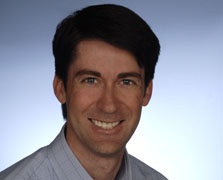
John Wagner
B.S., Computer Science, ‘92
Company: AgileThought, Inc.
Job Title: Chief Executive Officer
AgileThought is a full-service provider of software development and implementation solutions. Simply put, John and his team write custom software to help companies run their businesses more efficiently. AgileThought was recently named as the 8th fastest growing privately owned software company in the US by Inc. magazine as part of its annual Inc. 500 List. As CEO, John’s focus is on sales, business development and strategic planning, and he explains the many ways that his degree impacts his career.
“I think my computer science background helps me look at problems from a different angle than most people. I am always trying to decompose a problem into discrete parts that can be solved independent of each other.
“Probably the biggest thing I took away from my CS education was learning how to be persistent. I spent countless nights in the CS lab working all night long on code, sustaining myself on cold coffee and stale doughnuts from the Dunkin’ Donuts on Speedway. That’s where I learned not only about the craft of software construction, but also about what it means to love software development. When you get hooked on it, it is almost impossible to turn off that switch and go home.”
In addition to encouraging students to take advantage of all that the UA has to offer, John says, “I still can’t believe that I get paid to write software. For the CS students who truly love writing code, I would tell them that they should find a company that lets them pursue their passion.”
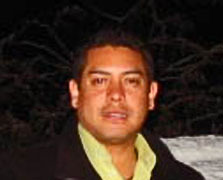
Juan R. Lobato
B.S., Computer Science, '98
Employer: Architectural Traditions
Job Title: Information Systems Director
Architectural Traditions, located in Tucson, Arizona, was founded 16 years ago by nationally recognized "Master Builder" Mark Butler, who specializes in building custom homes that are true to Southwestern architectural traditions. Today, Architectural Traditions is the only company of its kind that allows the builder, architect, designer and/or homeowner complete control, ensuring that the windows, doors and hardware are built with a consistent look and quality that only a single-source supplier can offer.
As the information systems director, Juan’s responsibilities include oversight of the plant’s computer systems, development and enhancement of current configuration type software, implementation of the back-end system, forecasting, fiscal oversight as well as intangible asset protection.
Juan explains the benefits of his computer science degrees, “One of the important aspects of computer science was not only the ability to design and develop new computer systems and applications, but also to understand and recognize the need for a new system, and execute and develop this need in such a way that addresses the problem of a given industry or business.”
What advice does Juan offer students earning their computer science degree? “We all have a passion for something, something that we have in our mind and we want to express it one way or another. To me, software development is that passion because you can turn complex problems into simple solutions in any industry. Wake up every morning and think ‘what am I going to invent today?’”
Industrial Partners
The Industrial Partners program provides companies with the opportunity to directly recruit students for internships and jobs. Click on Industrial Partners to learn more about the program benefits and how to become a member.
Investing in Computer Science
This is an exciting time for the department. Faculty research collaborations that address critical needs continue to increase, and the department welcomed 116 new undergraduates, 12 new MS, and 12 new PhDs. Advancing the academic and research excellence of the Department is an important goal. As the university relies less and less on state funds, the need for private support from alumni becomes even more necessary. We hope that after reading our fall newsletter that you feel re-connected to your experience at the UA and that you will consider supporting one of the Department’s key areas.
For example, alumni can impact a computer science student by providing an annual academic scholarship. Also, donations can be directed toward assisting students with research projects as well as to funding graduate student outreach and recruitment. Thank you for considering our department in your charitable giving plans, and please email raustin@cs.arizona.edu if you have any questions.
Contact Us
Please stay in touch! Let us know if your contact information has changed and what's new in your life. Send your updates to: raustin@cs.arizona.edu. Visit Updates & News and read about what some of the CS alumni are now doing.
